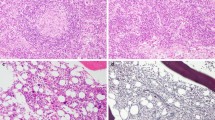Abstract
Hypereosinophilic syndromes (HES) constitute a rare and heterogeneous group of disorders, defined as persistent and marked blood eosinophilia associated with evidence of eosinophil-induced organ damage. Cardiac dysfunction is the most frequent result of end-organ damage and is the major cause of morbidity and mortality among patients with HES. Despite patients with FIP1-like-1-platelet-derived growth factor alpha (FIP1L1-PDGFRA) associated HES (myeloid neoplasms associated with PDGFRA rearrangement) have been shown to respond to low-dose imatinib with a complete and durable hematological and cytogenetic remission, influences of imatinib on clinical manifestations related to hypereosinophilia heart involvement are variable. Here we describe the case of a young male patient with severe heart involvement who had a prompt, clinical and hematological complete remission following administration of imatinib. However, as endomyocardial fibrosis and related loss of function are deteriorated after initiation of imatinib therapy, valvular replacement and tricuspid annuloplasty had to perform to restore his heart function. Our finding concurs with recent reports that severe heart involvement was irreversible with imatinib treatment.



Similar content being viewed by others
References
Weller PF, Bubley GJ. The idiopathic hypereosinophilic syndrome. Blood. 1994;83:2759–79.
Assa’ad AH, Spicer RL, Nelson DP, Zimmermann N, Rothenberg ME. Hypereosinophilic syndromes. Chem Immunol. 2000;76:208–29. doi:10.1159/000058787.
Fauci AS, Harley JB, Roberts WC, Ferrans VJ, Gralnick HR, Bjornson BH. NIH conference: the idiopathic hypereosinophilic syndrome—clinical, pathophysiologic, and therapeutic considerations. Ann Intern Med. 1982;97:78–92.
Ault P, Cortes J, Koller C, Kaled E, Kantarjian H. Response of idiopathic hypereosinophilic syndrome to treatment with imatinib mesylate. Leuk Res. 2002;26:881–4. doi:10.1016/S0145-2126(02)00046-2.
Wilkins HJ, Crane MM, Copeland K, Williams WV. Hypereosinophilic syndrome: an update. Am J Hematol. 2005;80:148–57. doi:10.1002/ajh.20423.
Tefferi A, Vardiman JW. Classification and diagnosis of myeloproliferative neoplasms: the 2008 World Health Organization criteria and point-of-care diagnostic algorithms. Leukemia. 2008;22:14–22. doi:10.1038/sj.leu.2404955.
Cools J, Stover EH, Gilliland DG. Detection of the FIP1L1-PDGFRA fusion in idiopathic hypereosinophilic syndrome and chronic eosinophilic leukemia. Methods Mol Med. 2006;125:177–87.
Chusid MJ, Dale DC, West BC, Wolff SM. The hypereosinophilic syndrome: analysis of fourteen cases with review of the literature. Medicine (Baltimore). 1975;54:1–27. doi:10.1097/00005792-197501000-00001.
Gotlib J, Cools J, Malone JM, Schrier SL, Gilliland DG, Coutre SE. The FIP1L1-PDGFRα fusion tyrosine kinase in hypereosinophilic syndrome and chronic eosinophilic leukemia: implications for diagnosis, classification, and management. Blood. 2004;103:2879–91. doi:10.1182/blood-2003-06-1824.
Kalac M, Quintás-Cardama A, Vrhovac R, Kantarjian H, Verstovsek S. A critical appraisal of conventional and investigational drug therapy in patients with hypereosinophilic syndrome and clonal eosinophilia. Cancer. 2007;110(5):955–64. doi:10.1002/cncr.22920.
Roufosse FE, Goldman M, Cogan E. Hypereosinophilic syndromes. Orphanet J Rare Dis. 2007;2:37–48. doi:10.1186/1750-1172-2-37.
Cools J, DeAngelo DJ, Gotlib J, et al. A tyrosine kinase created by fusion of the PDGFRA and FIPL1 genes as a therapeutic target of imatinib in idiopathic hypereosinophilic syndrome. N Engl J Med. 2003;348:1201–14. doi:10.1056/NEJMoa025217.
Cortes J, Ault P, Koller C, et al. Efficacy of imatinib mesylate in the treatment of idiopathic hypereosinophilic syndrome. Blood. 2003;101:4714–6. doi:10.1182/blood-2003-01-0081.
Cervetti G, Galimberti S, Carulli G, Petrini M. Imatinib therapy in hypereosinophilic syndrome: a case of molecular remission. Leuk Res. 2005;29:1097–8. doi:10.1016/j.leukres.2005.02.014.
Pardanani A, Ketterling RP, Li CY, et al. FIP1L1-PDGFRA in eosinophilic disorders: prevalence in routine clinical practice, long-term experience with imatinib therapy, and a critical review of the literature. Leuk Res. 2006;30:965–70. doi:10.1016/j.leukres.2005.11.011.
Baccarani M, Cilloni D, Rondoni M, et al. The efficacy of imatinib mesylate in patients with FIP1l1-PDGFRalpha-positive hypereosinophilic syndrome: results of a multicenter prospective study. Haematologica. 2007;92:1173–9. doi:10.3324/haematol.11420.
Anghel G, De Rosa L, Ruscio C, et al. Efficacy of imatinib mesylate in a patient with idiopathic hypereosinophilic syndrome and severe heart involvement. Tumori. 2005;91:67–70.
Onitilo AA, Kio EA, Singh AK, Lazarchick J. Cytogenetic remission with imatinib therapy in hypereosinophilic syndrome with trisomy 8 and resolution of severe cardiac dysfunction. Leuk Lymphoma. 2005;46:1667–70. doi:10.1080/10428190500220514.
Klion AD, Robyn J, Akin C, et al. Molecular remission and reversal of myelofibrosis in response to imatinib mesylate treatment in patients with the myeloproliferative variant of hypereosinophilic syndrome. Blood. 2004;103:473–8. doi:10.1182/blood-2003-08-2798.
Vandenberghe P, Wlodarska I, Michaux L, et al. Clinical and molecular features of FIP1L1-PDFGRA (+) chronic eosinophilic leukemias. Leukemia. 2004;18:734–42. doi:10.1038/sj.leu.2403313.
Klion AD, Noel P, Akin C, et al. Elevated serum tryptase levels identify a subset of patients with a myeloproliferative variant of idiopathic hypereosinophilic syndrome associated with tissue fibrosis, poor prognosis, and imatinib responsiveness. Blood. 2003;101:4660–6. doi:10.1182/blood-2003-01-0006.
Jovanovic JV, Score J, Waghorn K, et al. Low-dose imatinib mesylate leads to rapid induction of major molecular responses and achievement of complete molecular remission in FIP1L1-PDGFRA-positive chronic eosinophilic leukemia. Blood. 2007;109:4635–40. doi:10.1182/blood-2006-10-050054.
Klion AD, Robyn J, Maric I, et al. Relapse following discontinuation of imatinib mesylate therapy for FIP1L1/PDGFRA-positive chronic eosinophilic leukemia: implications for optimal dosing. Blood. 2007;110:3552–6. doi:10.1182/blood-2007-07-100164.
Author information
Authors and Affiliations
Corresponding author
Electronic supplementary material
Below is the link to the electronic supplementary material.
About this article
Cite this article
Sun, CY., Hu, Y., Chu, ZB. et al. Successful treatment of myeloid neoplasms associated with PDGFRA rearrangement with imatinib mesylate. Int J Hematol 89, 66–70 (2009). https://doi.org/10.1007/s12185-008-0205-1
Received:
Revised:
Accepted:
Published:
Issue Date:
DOI: https://doi.org/10.1007/s12185-008-0205-1




